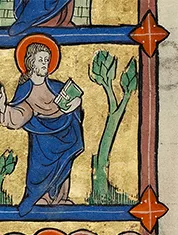Illuminating Networks of Gothic Manuscripts: Alex Brey (HART ’18) and Maeve Doyle (HART ’15) Awarded Prestigious Getty Foundation Placement

History of Art alumni Maeve Doyle and Alex Brey have been accepted to participate in a prestigious one-year Getty Advanced Workshop, Network Analysis + Digital Art History (NA+DAH),at the University of Pittsburgh.The workshop incorporates projects by seven teams with the goal of fostering interdisciplinary collaboration between art historians and specialists in digital scholarship. NA + DAH is sponsored through the Digital Art History initiative of the Getty Foundation.
Alex and Maeve will undertake the joint project “Modeling Networks of Artistic Contact in French Gothic Manuscripts, 1260-1320,” a fresh look at medieval illuminated manuscripts produced by metropolitan and provincial French manuscript workshops. Using published catalogs of manuscripts and their marginal illuminations – ornamented with paint and gold leaf – the project aims to reconstruct commercial manufacturing networks between medieval manuscript workshops across Gothic France.
While illuminated manuscripts are often popularly associated with medieval European monasteries, Maeve and Alex highlight the growing role of private workshops hired by royal and aristocratic patrons living in and around the major urban centers of France from the 13th century onwards. The pair will bring together their complementary skills to build the project. Maeve brings specialist expertise on the production and patronage of French manuscripts, whereas Alex has read more deeply on the methodology of network analysis and brings a set of digital skills to the project. As they note, “Both of us come at this as art historians interested in the processes by which visual cultures are produced, sustained, and transformed. Our different backgrounds and intersecting interests make the collaboration mutually rewarding.”
Drawing on both of their collaborative powers, Alex and Maeve employ “a set of methods for modeling and measuring the connections of elements in networks, which were developed in the discipline of social network analysis.” Through social network analysis they hope to reveal new facets of the social milieu of artists and workshops in France during the nascent years of the highly transformative and artistically innovative “Gothic” style, between 1260 and 1320. They believe that a diachronic approach known as “temporal network analysis” will allow them to trace how the collaborative networks and visual vocabularies of medieval artistic workshops evolved over the decades.” Finally, the necessary reliance on 20th- and 21st- century catalogs for data about artists and workshops gives the project a historiographic dimension.
Some of their work draws on research interests explored while graduate students in the History of Art Department at Bryn Mawr. Part of their study will include mapping networks of visual motifs that appear in the French Gothic manuscripts. In particular, they will track the appearance of idiosyncratic images that appear in the margins of the texts. Maeve notes that this develops an interest sparked in one of the first classes she took at Bryn Mawr - a graduate seminar on “The Margins of Medieval Art” with Dr. Martha Easton.
Maeve Doyle is Assistant Professor of Art History at Eastern Connecticut State University. Alex Brey is a Postdoctoral Research Associate at the Center for the Advanced Study in the Visual Artsat the National Gallery of Art, Washington, D.C.